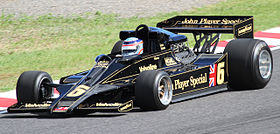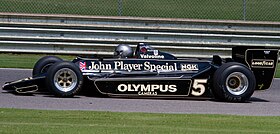Team Rebaque
| Surname | Team Rebaque |
|---|---|
| Companies | Team Rebaque |
| Company headquarters | Leamington Spa , ( GB ) |
| Team boss | Hector Rebaque |
| statistics | |
| First Grand Prix | Argentina 1978 |
| Last Grand Prix | USA East 1979 |
| Race driven | 18th |
| Constructors' championship | 0 |
| Drivers World Championship | 0 |
| Race wins | 0 |
| Pole positions | 0 |
| Fastest laps | 0 |
| Points | 1 |
The rebaque was one of héctor rebaque established team, the 1978 and 1979 at the Formula 1 took part in World Championship. Rebaque was the first Formula 1 team to compete with a Mexican license. The racing team initially operated as a customer team using the chassis from Lotus ; in the second year of its existence, however, it temporarily became an independent designer. The team took part in 30 Formula 1 races and scored a world championship point. After two years, the racing team ceased operations.
background
The Mexican Héctor Rebaque made his Formula 1 debut in 1977 when he competed in some races for the British team Hesketh . Rebaque was only able to qualify once in six attempts; in this race he retired after 20 laps. Since Rebaque could not find a cockpit at an established racing team for the coming season, he decided to found his own team, with which he competed in the 1978 Formula 1 World Championship. The Rebaque team was based in Leamington Spa , England , but still drove with a Mexican license.
1978 Formula 1 season

In 1978 the Rebaque team made their Formula 1 debut . Héctor Rebaque himself was reported as the driver . Along with Emerson Fittipaldi and Arturo Merzario, he was the only racing driver of the year who competed with his own team in all races of the season.
In its debut season, Team Rebaque used a used Lotus 78 built in 1977 that was powered by a Cosworth DFV eight-cylinder engine.
In sixteen attempts, Héctor Rebaque was able to qualify nine times; He finished four races with a finish. The first finish for his team he reached in the third race of the year, the Grand Prix of South Africa in Kyalami ; here he was tenth. Rebaque achieved his best result at the German Grand Prix : starting 18th, he finally crossed the finish line in sixth place ahead of John Watson in the Brabham- Alfa Romeo and in front of Gilles Villeneuve in the Ferrari . He won a point in the constructors' championship, which was credited to the Lotus team, as Lotus had designed the car.
1979 Formula 1 season

In 1979, Héctor Rebaque continued to work with his own racing team. For the first races of the year, the Rebaque team reported a Lotus 79 , the “outstanding car of the year 1978”, with which Mario Andretti had become Formula 1 world champion the year before and Lotus had won the constructors' championship. A Cosworth DFV motor served as the drive.
However, the Rebaque team was unable to convert the takeover of the Lotus 79 into successes of its own. In the first six races of the 1979 season, Héctor Rebaque was unable to reach the finish line: five times he was canceled due to technical defects or a driving error, and once - at the Brazilian Grand Prix - he missed qualification. The team did not compete for the seventh race of the season, the Monaco Grand Prix . In the summer, Rebaque was finally able to record three finishings; the best result was seventh place at the Dutch Grand Prix .
In the late summer of 1979, Rebaque replaced the Lotus 79 with the Rebaque HR 100 . This was a racing car that Penske had designed and built for Rebaques and which was essentially a copy of the Lotus 79. The HR 100 made its debut at the 1979 Italian Grand Prix. Rebaque was more than 8 seconds slower in qualifying than Jean-Pierre Jabouille , who later started the race from pole position . Rebaque, on the other hand, clearly missed qualifying at this time. At the subsequent Canadian Grand Prix he was able to qualify as 22nd, but retired from the race after 31 laps after a break in the engine mount. At the last race of the season in the USA , Rebaque again missed qualification. This was the last attempt to qualify an HR 100 for a Formula 1 race.
For the 1980 season, Rebaque was considering building a new car. However, these considerations could not be implemented; the Rebaque team ceased operations at the end of the year. This is partly attributed to difficulties with the tire supply or with the registration. Rebaque continued his motorsport career as a driver in the Brabham works team in 1980 and 1981 .
Sports car
The team was active in sports car racing long before it became involved in Formula 1. So the Mexican racing team came to Europe in 1974 to compete in the Le Mans 24-hour race . In addition to Héctor Rebaque, his compatriot Guillermo Rojas, who also acted as team partner, drove the Porsche 911 Carrera RSR . After only 60 laps, the Porsche broke down prematurely due to damage to the ignition.
literature
- Adriano Cimarosti : The Century of Racing. Stuttgart 1997, ISBN 3-613-01848-9
- David Hodges: AZ of Grand Prix Cars 1906–2000 , 1st edition London 2001, ISBN 1861263392 (English)
- David Hodges: Racing cars from AZ after 1993 . Stuttgart 1993, ISBN 3-613-01477-7 .
Individual evidence
- ^ Biography of Héctor Rebaques on the website www.forix.com (accessed December 27, 2010).
- ↑ Other drivers who had their own teams were Emilio de Villota (Centro Asegurador F1) and Tony Trimmer (Melchester Racing); however, they only competed in individual races.
- ↑ Overview of the distribution of points for the 1978 season at Hodges: Racing cars from AZ after 1945, p. 275.
- ↑ Cimarosti, p. 283.
- ↑ Cimarosti, p. 293.
- ^ Biography of Héctor Rebaques on the website www.forix.com (accessed December 27, 2010).
- ↑ Hodges: AZ of Grand Prix Cars 1906–2001, p. 196.
- ↑ Hodges: Racing Cars from AZ after 1945, p. 220.